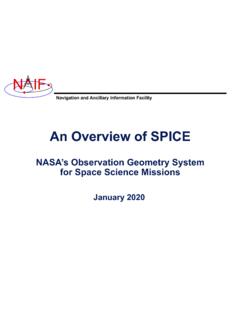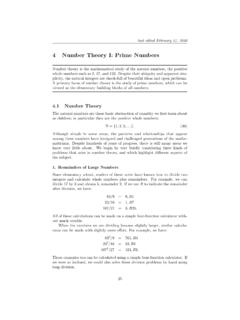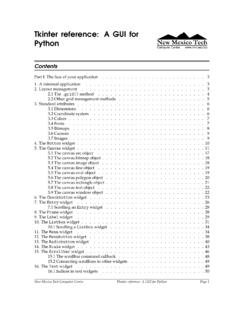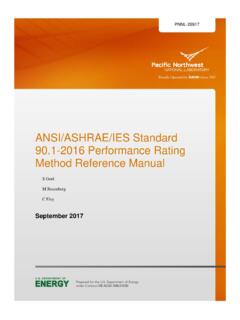Transcription of Using manipulatives to teach elementary mathematics - ed
1 Journal of Instructional Pedagogies Using manipulatives to teach , Page 1 Using manipulatives to teach elementary mathematics Matthew Boggan Mississippi State University Sallie Harper Mississippi State University Anna Whitmire Mississippi State University ABSTRACT The purpose of this paper is to explain the importance and benefits of math manipulatives . For decades, the National Council of Teachers of mathematics has encouraged school districts nationwide to use manipulatives in mathematical instruction. The value of manipulatives has been recognized for many years, but some teachers are reluctant to use them in their lessons.
2 Throughout this paper, a discussion of the positive results of several research studies that strongly suggest the use of manipulatives will be mentioned. The history and advancement of manipulatives with also be discussed. Defining manipulatives and explaining the correct way to use them will be highlighted in this paper. Keywords: manipulatives , instructional methods, mathematics , instruction, NCTM, reluctant Journal of Instructional Pedagogies Using manipulatives to teach , Page 2 INTRODUCTION According to the Principles and Standards for School mathematics , the foundation for children s mathematical development is established in the early years (Seefeldt & Wasik, 2006, p.)
3 249). It is important for children to have a variety of materials to manipulate and the opportunity to sort, classify, weigh, stack and explore if they are to construct mathematical knowledge. In order to have opportunities to learn math, children need firsthand experiences related to math, interaction with other children and adults concerning these experiences and time to reflect on the experiences (Seefeldt & Wasik, 2006, p. 250). Educational research indicated that the most valuable learning occurs when students actively construct their own mathematical understanding, which is often accomplished through the use of manipulatives .
4 HISTORY OF manipulatives Since ancient times, people of several different civilizations have used physical objects to help them solve everyday math problems. The ancient civilizations of Southwest Asia used counting boards, which were wooden or clay trays covered in a thin layer of sand. The counting board users would draw symbols in the sand to tally inventory or whatever else they may need to count. The ancient Romans created the first abacus based on counting board. The abacus was made of beans or stones which moved in grooves in sand or on tables of wood, stone, or metal.
5 The Chinese abacus, which came into use centuries later, may have been an adaptation of the Roman abacus ( Research on the ). The Mayans and the Aztecs both had counting devices that were made of corn kernels strung on string or wires that were stretched across a wooden frame. The Incas also had their own counting tool, which was knotted strings called quipu ( Research on the , ). The late 1800s saw the invention of the first true manipulative-maneuverable objects that appeal to several different senses and are specifically designed for teaching mathematical concepts ( Research on the ).
6 In 1837, German educator Friedrich Froebel introduced the world s first kindergarten. He designed the educational play materials known as Froebel Gifts, or Frobelgaben, which included geometric building blocks and pattern activity blocks ( Friedrich Froebel , 2009). Then in the early 1900s, Italian educator Maria Montessori continued with the idea that manipulatives are important to education. She designed several materials to help elementary students learn the basic ideas of math. Since the 1900s, manipulatives have come to be considered essential in teaching mathematics at the elementary school level ( Research on the, ).
7 In fact, the National Council of Teachers of mathematics (NCTM) has recommended the use of manipulatives in teaching mathematical concepts at all grade levels. manipulatives DEFINED manipulatives can come in a variety of forms and they are often defined as physical objects that are used as teaching tools to engage students in the hands-on learning of mathematics ( Using manipulatives , 2009). manipulatives can be purchased at a store, brought from home, or teacher and student made. The manipulatives can range from dried beans and bottle caps to Unifix cubes and base-ten blocks.
8 They are used to introduce, practice, or remediate a math concept. A good manipulative bridges the gap between informal math and Journal of Instructional Pedagogies Using manipulatives to teach , Page 3 formal math. To accomplish this objective, the manipulative must fit the developmental level of the child (Smith, 2009, p. 20). Kindergarten children should have individual counters, whereas older students could use colored wooden rods that represent different numbers. The manipulative must fit the mathematical ability of the child or it is useless. WAYS TO USE manipulatives manipulatives can be used in teaching a wide variety of topics in mathematics , including the objectives from the five NCTM standards: problem solving, communicating, reasoning, connections, and estimation.
9 The materials should foster children s concepts of numbers and operations, patterns, geometry, measurement, data analysis, problem solving, reasoning, connections, and representations (Seefeldt & Wasik, 2006, ). Teachers could use counters, place-value mats, base-ten blocks, and fraction strips while teaching from the numbers and operations standard. The counters could be used to teach one-on-one correspondence, ordinal numbers, and basic addition and subtraction. The fraction strips could be used to add and subtract fractions or to show equivalent fractions. Pattern blocks, attribute blocks and scales could be used to assist students in the learning basic algebra.
10 Student could use geoboards when trying to identify simple geometric shapes. They could also use geometric solid models when learning about spatial reasoning. Teachers could use standard and non-standard rulers and measuring cups to represent length or volume in measurement lessons. The students could also use tiles when trying to find the area or perimeter of an object. When it comes to data analysis and probability, students could use spinners to find the probability of landing on a designated area. They could also use number cases or dice to find the probability of rolling a certain number or combination of numbers ( Using manipulatives , 2009).
















